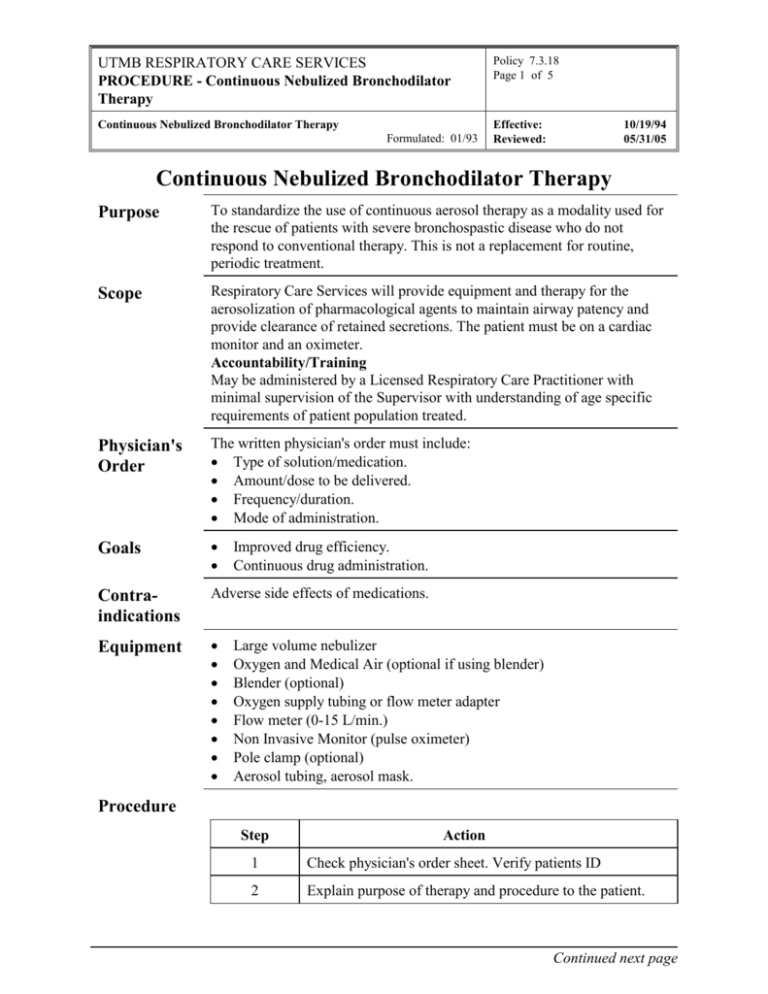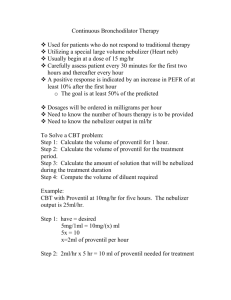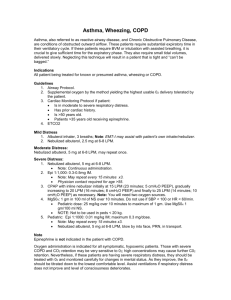Continuous Nebulized Bronchodilator Treatment
advertisement

UTMB RESPIRATORY CARE SERVICES PROCEDURE - Continuous Nebulized Bronchodilator Therapy Policy 7.3.18 Page 1 of 5 Continuous Nebulized Bronchodilator Therapy Effective: Reviewed: Formulated: 01/93 10/19/94 05/31/05 Continuous Nebulized Bronchodilator Therapy Purpose To standardize the use of continuous aerosol therapy as a modality used for the rescue of patients with severe bronchospastic disease who do not respond to conventional therapy. This is not a replacement for routine, periodic treatment. Scope Respiratory Care Services will provide equipment and therapy for the aerosolization of pharmacological agents to maintain airway patency and provide clearance of retained secretions. The patient must be on a cardiac monitor and an oximeter. Accountability/Training May be administered by a Licensed Respiratory Care Practitioner with minimal supervision of the Supervisor with understanding of age specific requirements of patient population treated. Physician's Order The written physician's order must include: Type of solution/medication. Amount/dose to be delivered. Frequency/duration. Mode of administration. Goals Contraindications Adverse side effects of medications. Equipment Improved drug efficiency. Continuous drug administration. Large volume nebulizer Oxygen and Medical Air (optional if using blender) Blender (optional) Oxygen supply tubing or flow meter adapter Flow meter (0-15 L/min.) Non Invasive Monitor (pulse oximeter) Pole clamp (optional) Aerosol tubing, aerosol mask. Procedure Step Action 1 Check physician's order sheet. Verify patients ID 2 Explain purpose of therapy and procedure to the patient. Continued next page UTMB RESPIRATORY CARE SERVICES PROCEDURE - Continuous Nebulized Bronchodilator Therapy Policy 7.3.18 Page 2 of 5 Continuous Nebulized Bronchodilator Therapy Effective: Reviewed: Formulated: 01/93 10/19/94 05/31/05 Procedure Continued Step Action 3 Wash hands. 4 Patient Assessment Heart rate Respiratory rate Skin color Breath sounds Chest excursion Mental status Airway status 5 Attach flow meter to source gas. 6 Attach oxygen supply tubing to flow meter and to NEBULIZER source gas inlet, or using flow meter adapter, attach to flow meter. Use pole clamp to hold nebulizer if not using flow meter adapter. 7 Attach corrugated tubing to nebulizer and aerosol mask. 8 Obtain mixed medication from pharmacy or see calculation protocol below. 9 Obtain mixed medication from pharmacy or see calculation protocol below. 10 Pour medication into nebulizer. 11 Set flow meter to 10 l/min. 12 Attach mask to patient. 13 Be sure to check nebulizer Q 1 Hour. x 2 to determine approximate loss of medication. Goal is to nebulize 30 cc/hr. (Incremental marks on nebulizer are 20cc's.) 14 Adjust flow meter by 1 L/min increments to establish desired output. 15 Change nebulizer every 24 hours. DO NOT REUSE. Continued next page UTMB RESPIRATORY CARE SERVICES PROCEDURE - Continuous Nebulized Bronchodilator Therapy Policy 7.3.18 Page 3 of 5 Continuous Nebulized Bronchodilator Therapy Effective: Reviewed: Formulated: 01/93 Continuation of Therapy 10/19/94 05/31/05 A physician who has directly observed the patient should reorder the treatment every 8 hours. On rounds check physician's order sheet, check position and fitting of apparatus, check for adequate flow. Always check the patient's response to therapy. Record pertinent data on the RCS flowsheet, and on RCS department treatment card. Discontinua- Check physician's order sheet. Explain change in therapy to patient. tion Discard all disposable equipment. Record the date and time the therapy was discontinued on the RCS flow sheet and on department treatment card. Undesirable Side Effects Tachycardia Palpitation Headache Nausea Assessment of Outcome The effectiveness of continuous aerosol treatment will be judged on how well it accomplishes the stated clinical goals. Observation of the following should be noted on the RCS flow sheet and in the patient progress notes. Includes, but is not limited to: Sputum - color, amount, consistency. Auscultation - comparison of pre- and post-treatment breath sounds; breath sounds improved. Arterial blood gas measurement and/or pulse oximetry. Work of breathing - evaluating the ventilatory pattern, use of accessory muscles; decreased WOB. Change in heart rate. Patient's subjective response ("breathing easier"). Peak flow improvement. Patient Teaching Step Action 1 Explain to the patient why he/she is receiving continuous aerosol treatment. Relate it to the disease or injury state. 2 Place in the proper body alignment for maximal breathing efficiency. 3 Perform proper cough instruction or cough assistance. Continued next page UTMB RESPIRATORY CARE SERVICES PROCEDURE - Continuous Nebulized Bronchodilator Therapy Policy 7.3.18 Page 4 of 5 Continuous Nebulized Bronchodilator Therapy Effective: Reviewed: Formulated: 01/93 10/19/94 05/31/05 Patient Teaching Continued Step Infection Control Action 4 Explain how to breathe through the mouth or trach and to breathe slowly and deeply - a slight inspiratory pause is ideal. 5 Show how to breathe diaphragmatically to assure that the maximum distribution and deposition of aerosol will occur in the basilar areas of the lung. 6 Alert patient to possible onset of strong cough. 7 As a result of the educational aspects of this therapy, the patient should be able to verbalize and demonstrate understanding of this therapy. Follow procedures outlined in Healthcare Epidemiology Policies and Procedures #2.24; Respiratory Care Services. http://www.utmb.edu/policy/hcepidem/search/02-24.pdf Correspond- RCS Policy and Procedure Manual, Guidelines for Medical Record Documentation, #7.1.1. ing Policies RCS Policy and Procedure Manual, Therapist Treatment Cards, # 7.1.2. Safety Instruct patient and visitors in safety rules for oxygen. Safety guidelines as outlined in section 3.6.1 of this manual will be followed. Attachments Medication calculation chart. References Berlinski A, Waldrep JC. Four Hours of Continuous Albuterol Nebulization. Chest. 1998; 114:847-853.Baker EK, Willsie SK, Marinac JS, Salzman GA. Continuously nebulized albuterol in severe exacerbations of asthma in adults: a case-controlled study. Journal of Asthma. 1997; 34:52130. Craig VL, Bigos D, Brilli RJ. Efficacy and safety of continuous albuterol nebulization in children with severe status asthmaticus. Pediatric Emergency Care. 1996; 12:1-5. Continued next page UTMB RESPIRATORY CARE SERVICES PROCEDURE - Continuous Nebulized Bronchodilator Therapy Policy 7.3.18 Page 5 of 5 Continuous Nebulized Bronchodilator Therapy Effective: Reviewed: Formulated: 01/93 References Continued 10/19/94 05/31/05 Shrestha M, Bidadi K, Gourlay S, Hayes J. Continuous vs intermittent albuterol, at high and low doses, in the treatment of severe acute asthma in adults. Chest. 1996; 110:42-7 Moler FW, Johnson CE, Van Laanen C, et al. Continuous versus intermittent nebulized terbutaline: plasma levels and effects. American Journal of Respiratory Critical Care Medicine. 1995; 151:602-6. Moler Fw, Hurwitz ME, Custer JR. Improvement in Clinical Asthma Score and PaCO2 in Children With Severe Asthma Treated With Continuously Nebulized Terbutaline. Journal of Allergy & Clinical Immunology 1988, 81:1101-1109.





